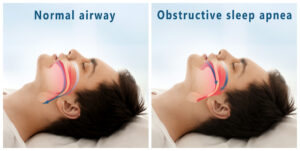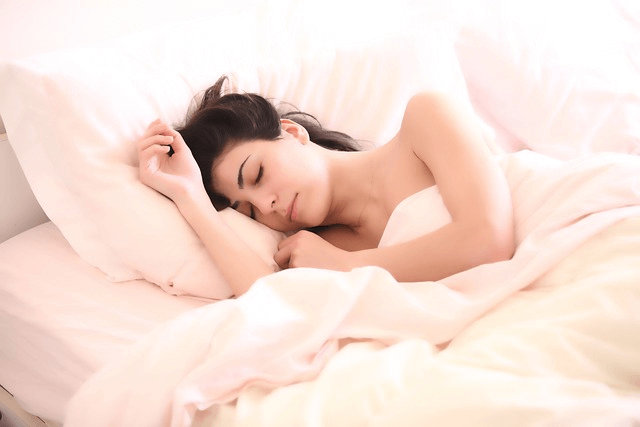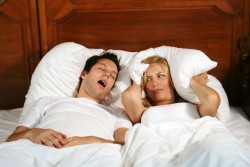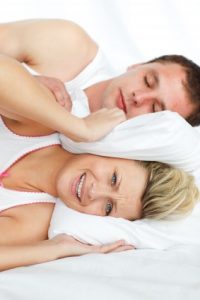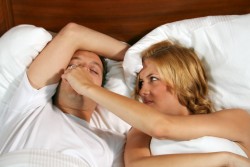
Do you struggle with sleep apnea, constantly searching for a treatment that suits your needs? A mouthguard for sleep apnea could be the answer, offering a more comfortable and manageable alternative to traditional therapies. In this blog post, we’ll explore sleep apnea mouthguards and their effectiveness in treating this common sleep disorder.
Key Takeaways
- Mouthguards are a viable treatment option for obstructive sleep apnea, but potential side effects and risks should be discussed with a healthcare provider.
- A comprehensive evaluation of the effectiveness of mouthguards is essential to determine their suitability in treating sleep apnea.
- Lifestyle changes such as diet modification, reducing stress levels and physical activity can help improve overall health outcomes associated with sleep apnea.
Understanding Sleep Apnea and Mouthguards
Sleep apnea is a serious sleep disorder characterized by repeated interruptions in breathing during sleep, ranging from mild sleep apnea to severe obstructive sleep apnea. It can have significant impacts on your daily life, causing excessive daytime sleepiness and other health issues.
One of the treatment options to treat obstructive sleep apnea is the use of a sleep apnea device, such as mouthguards, which serve to open the airway by adjusting the position of the jaw or tongue, thereby preventing airway collapse during sleep. This makes them an effective option for treating obstructive sleep apnea, the most common form of the disorder.
Mouthguards are available in two main types: mandibular advancement devices (MADs) and tongue-retaining devices (TRDs). Both types aim to create more space in the throat and improve breathing, resulting in enhanced sleep quality, diminished snoring, and overall better health.
Nevertheless, as with any other treatment, sleep apnea mouthguards come with potential side effects and risks. Thus, consultation with a clinical sleep medicine specialist is advised to find the best solution for you.
What is Sleep Apnea?
Sleep apnea is characterized by recurrent pauses in respiration during slumber, resulting in disturbed sleep and potential health concerns. This sleep disorder can be classified into two primary types: obstructive sleep apnea (OSA) and central sleep apnea (CSA). OSA is caused by obstructions in the airway due to soft tissue in the back of the throat, resulting in recurrent, nightly breathing interruptions.
CSA is a less common form of sleep apnea in which the brain is unable to adequately signal the muscles responsible for breathing, leading to inconsistent contractions.
There are several treatment options for sleep apnea, including:
- Oral pressure therapy
- Orofacial therapy
- Continuous positive airway pressure (CPAP) therapy
- Dental devices
Each treatment carries its own benefits and drawbacks. Thus, it’s crucial for patients to collaborate with their healthcare providers to identify the most beneficial approach for their unique circumstances.
How Mouthguards Help with Sleep Apnea
Mouthguards, specifically sleep apnea mouth guards, play a vital role in treating sleep apnea by repositioning the jaw or tongue, thereby creating additional space in the throat and preventing airway collapse. This can lead to improved sleep quality, reduced snoring, and better overall health.
There are two primary types of mouthguards employed for sleep apnea: mandibular advancement devices (MADs) and tongue-retaining devices (TRDs). Both MADs and TRDs work by altering the position of the jaw or tongue, which can help to keep the airway open during sleep.
The benefits of utilizing a mouthguard for sleep apnea include enhanced sleep quality, diminished snoring, and enhanced breathing. However, keep in mind that mouthguards might not be the right choice for everyone. Potential side effects like jaw pain, discomfort, or speech difficulties should be taken into account before opting for this treatment.
Types of Mouthguards for Sleep Apnea
As mentioned earlier, there are two main types of sleep apnea mouthguards: mandibular advancement devices (MADs) and tongue-retaining devices (TRDs). Both types are designed to help alleviate sleep apnea symptoms by creating more space in the throat and preventing airway collapse.
This section will delve deeper into each type of device, highlighting their respective pros and cons. Grasping the differences between MADs and TRDs can help you and your healthcare provider choose the most appropriate treatment for your needs, thereby guaranteeing the most efficient solution for your sleep apnea.
Mandibular Advancement Devices (MADs)
Mandibular advancement devices (MADs) are custom-fitted plastic devices that move the lower jaw forward, opening the airway and reducing sleep apnea symptoms. They are estimated to be 65-80% as effective as a CPAP device when worn correctly. MADs must be fitted by a dentist or orthodontist and can be adjusted to suit the user’s oral and mandibular anatomy.
While MADs have proven effective for many sleep apnea patients, there are potential side effects to consider, such as jaw pain, excessive salivation, and tooth movement. Before you decide on this treatment, it’s vital that you discuss these potential side effects with your healthcare provider.
Tongue-Retaining Devices (TRDs)
Tongue-retaining devices (TRDs) are another type of sleep apnea mouthguard that works by holding the tongue forward during sleep, preventing it from obstructing the airway. TRDs use suction forces or negative pressure to displace the tongue and enhance respiration. Although TRDs can be effective in treating sleep apnea, their efficacy has not been as extensively studied as that of MADs, making them less commonly used.
Potential side effects of TRDs may include discomfort, soreness, and difficulty speaking. Like MADs, it’s important to consider discussing potential side effects and risks with your healthcare provider prior to settling on this treatment option.
Advantages of Using Mouthguards for Sleep Apnea
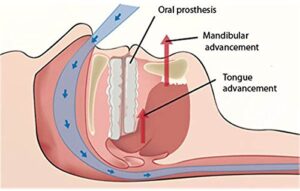
In addition to being more comfortable, mouthguards are also portable and easy to use, making them an attractive option for individuals who travel frequently or have difficulty using CPAP machines.
Ultimately, the effectiveness of the treatment will hinge on an individual’s specific needs and preferences. Therefore, maintaining close collaboration with your healthcare provider to identify the best strategy for your sleep apnea is crucial.
Potential Side Effects and Risks
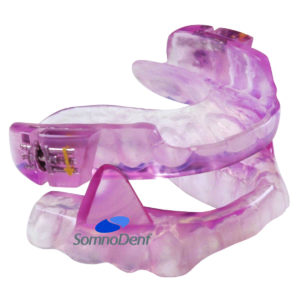
Despite these potential side effects, the advantages of using a mouthguard for sleep apnea generally outweigh the risks. To reduce the likelihood of side effects, scheduling regular follow-up appointments with your dentist and sleep physician to ensure the proper fit and effectiveness of the mouthguard is vital.
Determining the Effectiveness of Sleep Apnea Mouthguards
Evaluating the effectiveness of sleep apnea mouthguards in reducing interruptions in breathing and enhancing blood oxygen levels is crucial. This can be achieved through regular sleep study monitoring, which evaluates the efficacy of the mouthguard in treating your sleep apnea. Regular monitoring and adjustments by healthcare professionals are necessary to ensure the ongoing effectiveness of the mouthguard.
In some cases, sleep apnea mouthguards may not be suitable for everyone. Certain situations, such as severe sleep apnea or specific medical conditions, may make mouthguards an unsuitable treatment option.
When Not to Use a Sleep Apnea Mouthguard
Mouthguards are not recommended for use in certain circumstances, such as severe sleep apnea or specific medical conditions. Additionally, while mouthguards can be an effective temporary measure, they should not be used as a permanent solution for sleep apnea. Sleep apnea mouthguards are not designed for indefinite use and may need to be replaced after a year or two.
If mouthguards prove to be unsuitable, it becomes crucial to investigate other treatments, like CPAP therapy or surgical interventions, in order to effectively manage sleep apnea.
Obtaining and Adjusting Your Sleep Apnea Mouthguard
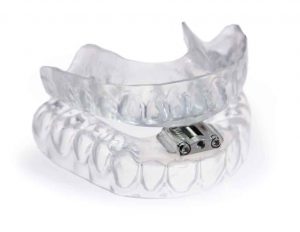
Making periodic adjustments to the mouthguard is advised to guarantee optimal treatment. Your dentist can provide guidance on the frequency of such adjustments to keep the mouthguard functioning effectively.
Monitoring Mouthguard Effectiveness
Continuous monitoring and timely adjustments by healthcare professionals are pivotal to maintain the effectiveness of mouthguards in treating sleep apnea. This includes:
- Scheduling regular follow-up appointments with your dentist and sleep physician
- Ensuring the mouthguard is still fitting correctly
- Ensuring the mouthguard is effectively treating your sleep apnea
Monitoring the effectiveness of your sleep apnea mouthguard through sleep study evaluations can help you and your healthcare provider determine if any adjustments are needed or if alternative treatment options should be explored.
Lifestyle Changes and Additional Treatment Options
In addition to using a sleep apnea mouthguard, certain lifestyle changes and additional treatment options can complement the mouthguard treatment and further improve sleep apnea symptoms. Some of these changes include:
- Quitting smoking
- Making dietary modifications
- Reducing stress levels
- Limiting alcohol consumption
Working closely with your healthcare provider to find the best combination of treatments and lifestyle changes tailored to your needs is crucial. Exploring a variety of treatment options can help ensure that you receive the most effective care to treat sleep apnea, improving your overall health and quality of life.
Weight Loss and Exercise
Losing weight and engaging in regular exercise can have significant benefits for individuals with sleep apnea, reducing the severity of the condition and improving overall health. Adopting a balanced diet, reducing alcohol consumption, and engaging in regular physical activity are all recommended weight loss strategies.
Weight loss and exercise can have several benefits, including:
- Markedly reducing symptoms such as daytime sleepiness, irritability, and other neuropsychiatric dysfunctions
- Enhancing cardiovascular health, hypertension, insulin resistance, and type 2 diabetes
- Improving or resolving sleep apnea by shedding as little as 5-10% of body weight.
Sleep Position and Environment
Adjusting sleep positions and optimizing the sleep environment can help alleviate sleep apnea symptoms and promote better sleep quality. For example, sleeping on one’s side can be beneficial in addressing sleep apnea symptoms, as opposed to sleeping on one’s back, which can exacerbate the condition due to the effect of gravity on the throat muscles.
To avoid sleeping on one’s back, consider using a device that emits an alert or sewing a tennis ball into the back of your sleepwear. Implementing these changes, in conjunction with using a sleep apnea mouthguard, can further improve your sleep quality and overall well-being.
Summary
In conclusion, sleep apnea mouthguards, such as mandibular advancement devices and tongue-retaining devices, offer a promising treatment option for those struggling with sleep apnea. While they may not be suitable for everyone, these devices can provide a more comfortable and manageable alternative to traditional therapies, such as CPAP machines. By working closely with your healthcare provider and making appropriate lifestyle changes, you can improve your sleep quality and overall well-being.
Frequently Asked Questions
Do mouthguards help with sleep apnea?
Mouthguards can help with sleep apnea by moving the jaw forward to open up the airway and reduce air resistance that causes snoring.
Can you use a mouth guard instead of a CPAP?
You have the choice to use a mouth guard or CPAP for sleep apnea treatment. Oral appliances have been approved as an alternative to CPAP for mild to moderate cases, and can be used in place of CPAP when it is not tolerated.
Is the mouth guard for sleep apnea FDA approved?
Yes, mouth guards for sleep apnea are FDA approved. Oral appliance therapy is gaining popularity as an alternative treatment to CPAP machines, and it uses FDA-approved mouth guards.
What are the main types of sleep apnea mouthguards?
The two main types of sleep apnea mouthguards are mandibular advancement devices (MADs) and tongue-retaining devices (TRDs), designed to help alleviate symptoms of the condition.
Are there any potential side effects of using sleep apnea mouthguards?
Using sleep apnea mouthguards may cause dental discomfort, malocclusion, and difficulty sleeping during the initial nights of treatment.

